Marketing Theory and Practice
VerifiedAdded on 2023/06/03
|10
|3097
|398
AI Summary
This essay analyzes both strategic choice and deterministic theories of organizational action, discussing their strengths and related arguments. It concludes that both theories are compelling in different environments and situations.
Contribute Materials
Your contribution can guide someone’s learning journey. Share your
documents today.
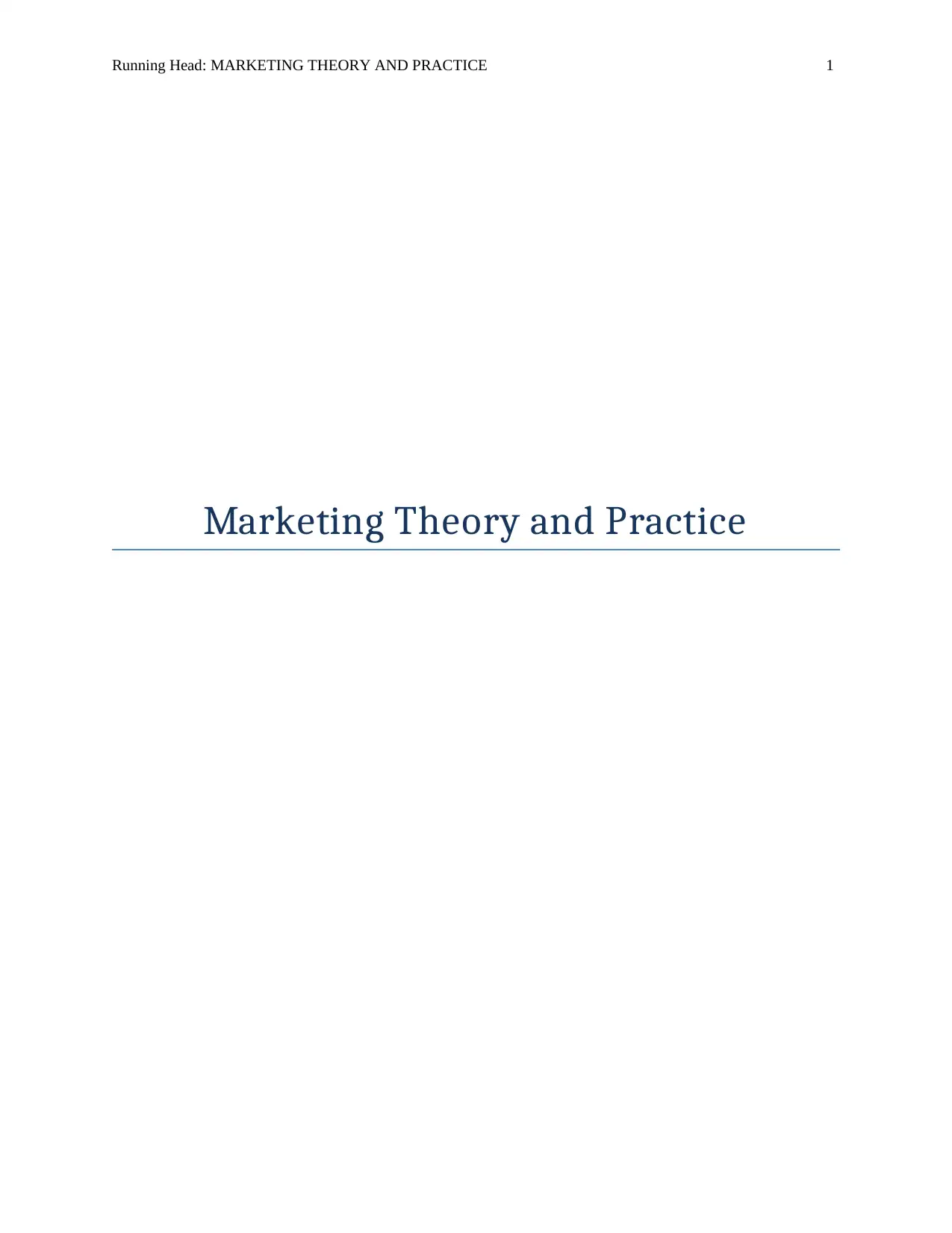
Running Head: MARKETING THEORY AND PRACTICE 1
Marketing Theory and Practice
Marketing Theory and Practice
Secure Best Marks with AI Grader
Need help grading? Try our AI Grader for instant feedback on your assignments.
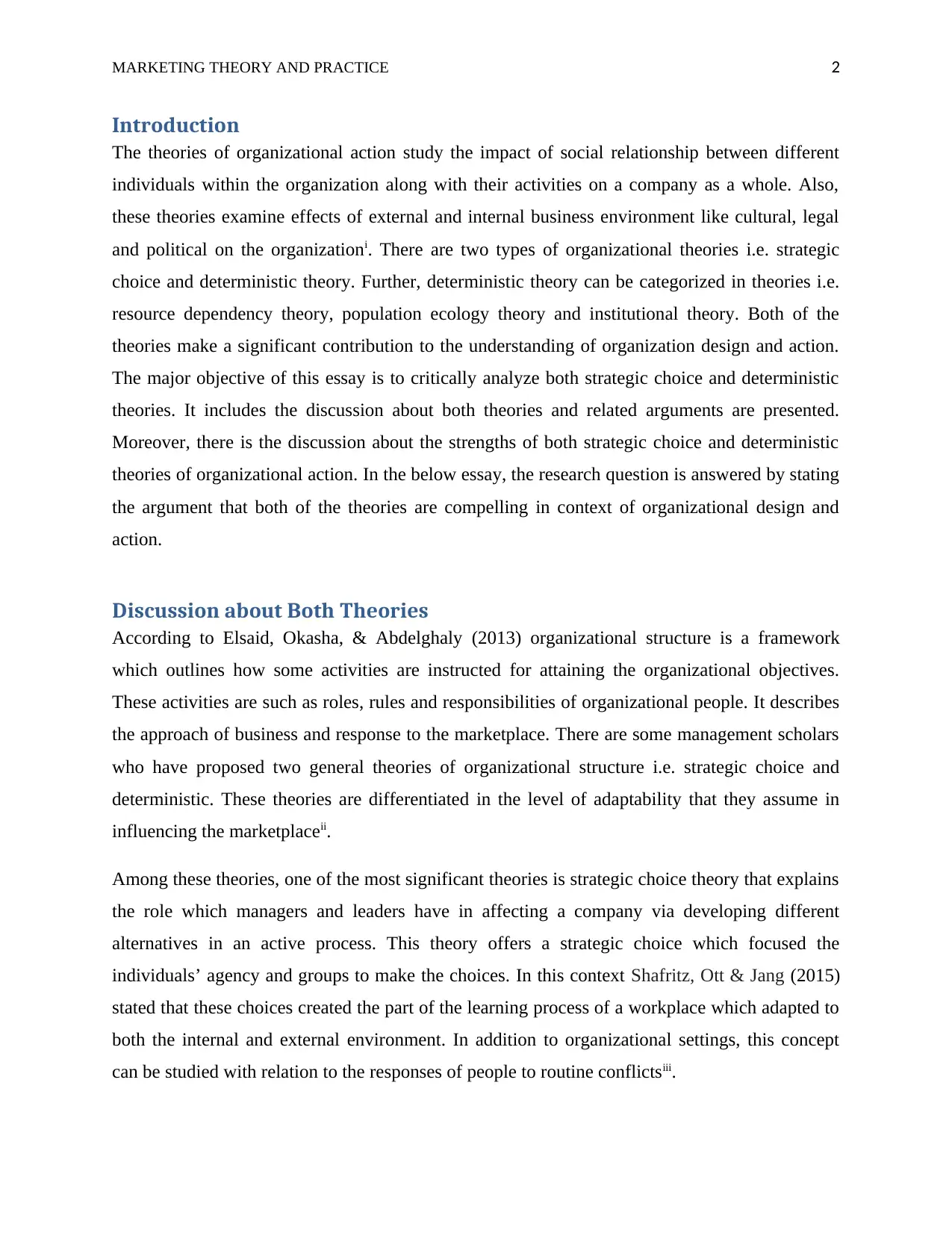
MARKETING THEORY AND PRACTICE 2
Introduction
The theories of organizational action study the impact of social relationship between different
individuals within the organization along with their activities on a company as a whole. Also,
these theories examine effects of external and internal business environment like cultural, legal
and political on the organizationi. There are two types of organizational theories i.e. strategic
choice and deterministic theory. Further, deterministic theory can be categorized in theories i.e.
resource dependency theory, population ecology theory and institutional theory. Both of the
theories make a significant contribution to the understanding of organization design and action.
The major objective of this essay is to critically analyze both strategic choice and deterministic
theories. It includes the discussion about both theories and related arguments are presented.
Moreover, there is the discussion about the strengths of both strategic choice and deterministic
theories of organizational action. In the below essay, the research question is answered by stating
the argument that both of the theories are compelling in context of organizational design and
action.
Discussion about Both Theories
According to Elsaid, Okasha, & Abdelghaly (2013) organizational structure is a framework
which outlines how some activities are instructed for attaining the organizational objectives.
These activities are such as roles, rules and responsibilities of organizational people. It describes
the approach of business and response to the marketplace. There are some management scholars
who have proposed two general theories of organizational structure i.e. strategic choice and
deterministic. These theories are differentiated in the level of adaptability that they assume in
influencing the marketplaceii.
Among these theories, one of the most significant theories is strategic choice theory that explains
the role which managers and leaders have in affecting a company via developing different
alternatives in an active process. This theory offers a strategic choice which focused the
individuals’ agency and groups to make the choices. In this context Shafritz, Ott & Jang (2015)
stated that these choices created the part of the learning process of a workplace which adapted to
both the internal and external environment. In addition to organizational settings, this concept
can be studied with relation to the responses of people to routine conflictsiii.
Introduction
The theories of organizational action study the impact of social relationship between different
individuals within the organization along with their activities on a company as a whole. Also,
these theories examine effects of external and internal business environment like cultural, legal
and political on the organizationi. There are two types of organizational theories i.e. strategic
choice and deterministic theory. Further, deterministic theory can be categorized in theories i.e.
resource dependency theory, population ecology theory and institutional theory. Both of the
theories make a significant contribution to the understanding of organization design and action.
The major objective of this essay is to critically analyze both strategic choice and deterministic
theories. It includes the discussion about both theories and related arguments are presented.
Moreover, there is the discussion about the strengths of both strategic choice and deterministic
theories of organizational action. In the below essay, the research question is answered by stating
the argument that both of the theories are compelling in context of organizational design and
action.
Discussion about Both Theories
According to Elsaid, Okasha, & Abdelghaly (2013) organizational structure is a framework
which outlines how some activities are instructed for attaining the organizational objectives.
These activities are such as roles, rules and responsibilities of organizational people. It describes
the approach of business and response to the marketplace. There are some management scholars
who have proposed two general theories of organizational structure i.e. strategic choice and
deterministic. These theories are differentiated in the level of adaptability that they assume in
influencing the marketplaceii.
Among these theories, one of the most significant theories is strategic choice theory that explains
the role which managers and leaders have in affecting a company via developing different
alternatives in an active process. This theory offers a strategic choice which focused the
individuals’ agency and groups to make the choices. In this context Shafritz, Ott & Jang (2015)
stated that these choices created the part of the learning process of a workplace which adapted to
both the internal and external environment. In addition to organizational settings, this concept
can be studied with relation to the responses of people to routine conflictsiii.

MARKETING THEORY AND PRACTICE 3
Apart from this, another theory is deterministic theory that states that the marketplace has an
effective control on the businesses which are operating in it. This theory asserts that companies
are pressurized to adapt or respond to the market changes. The concept of determinism can be
understood by looking at three theories i.e. population ecology, resource dependency and
institutional theory. All the theories indicate that organizations are controlled by different aspects
such as by other company’s resources as per resource dependency concept, rules, norms and
regulations as per institutional theory and external environment as per population ecology
theoryiv.
Option 2: Both are Compelling
Arguments
Looking at the explanation of both the theories, the fact should be noted that both theories create
a compelling impact on the organizational behaviour of an organization. In one hand strategic
choice refers to the role that leaders play in influencing the employees and making dynamic
choices in an organization. Whereas deterministic theory of organizational structure refers to the
structure that has comparatively less control on the functions in an organization and marketplace
controls the business. It should be noted that it depends upon the organization that which
structure that they have to choose for their business. It cannot be said that one theory is more
compelling than other is as all the organizations have diverse working environment and business
structures as well. Like, talking about a retail organization, it can be said that the companies
present in this industry would prefer strategic choice theory as it lays a consolidated control over
the functions and diverse choices in the environment as wellv.
However, in the case of deterministic theory, it would best fit to the social organizations like
NGOs as it expresses less control over the actions and let the market define the work and actions
that the organization have to implement. Like, the resource dependency theory let the
organization work according to the resources available with them but resources do not govern the
actions in other organization present in diverse industries. In the case of determinism theory, the
companies have to adopt changes present in the environment without opposing. Thus, it can be
said that it depend upon the organization and their capacity to adopt change that governs that
effectiveness of the theories on the management. Both the theory hold equal validity in the
Apart from this, another theory is deterministic theory that states that the marketplace has an
effective control on the businesses which are operating in it. This theory asserts that companies
are pressurized to adapt or respond to the market changes. The concept of determinism can be
understood by looking at three theories i.e. population ecology, resource dependency and
institutional theory. All the theories indicate that organizations are controlled by different aspects
such as by other company’s resources as per resource dependency concept, rules, norms and
regulations as per institutional theory and external environment as per population ecology
theoryiv.
Option 2: Both are Compelling
Arguments
Looking at the explanation of both the theories, the fact should be noted that both theories create
a compelling impact on the organizational behaviour of an organization. In one hand strategic
choice refers to the role that leaders play in influencing the employees and making dynamic
choices in an organization. Whereas deterministic theory of organizational structure refers to the
structure that has comparatively less control on the functions in an organization and marketplace
controls the business. It should be noted that it depends upon the organization that which
structure that they have to choose for their business. It cannot be said that one theory is more
compelling than other is as all the organizations have diverse working environment and business
structures as well. Like, talking about a retail organization, it can be said that the companies
present in this industry would prefer strategic choice theory as it lays a consolidated control over
the functions and diverse choices in the environment as wellv.
However, in the case of deterministic theory, it would best fit to the social organizations like
NGOs as it expresses less control over the actions and let the market define the work and actions
that the organization have to implement. Like, the resource dependency theory let the
organization work according to the resources available with them but resources do not govern the
actions in other organization present in diverse industries. In the case of determinism theory, the
companies have to adopt changes present in the environment without opposing. Thus, it can be
said that it depend upon the organization and their capacity to adopt change that governs that
effectiveness of the theories on the management. Both the theory hold equal validity in the

MARKETING THEORY AND PRACTICE 4
environment, it is the discretion of the business structure of the companies to implement the
theories in their business. The external environment of organizations govern the business choices
of the company, however some companies have more choices in the business to make while
others have less. But, on the basis of this differentiation it cannot be regarded as one is more
compelling than other. Both the theories have equal capacity to affect the decisions in an
organization.
Highlight Strengths of Strategic Choice Theory
Strategic Choice approach focuses on the decisions that are to be made on the basis of particular
situations in the market. According to the theory of strategic choice, an organization and its
leader gets variety of options in the market to choose. This approach helps in defining various
choices that an organization can make to in order to receive better outcomes from the market.
Previously, it was assumed that the organizations were ought to be designed according to the
operational environment and factors present in the external environment. However, with the
change in scenarios the fact came into existence that companies get various choices in the
environment to move ahead in the market. With the help of this type of theory, an organization
can easily differentiate its business function in the environment with the help of strategic choices
that they make in the environment. This type of theory emphasize on different alternatives
present in the environment and to choose the best one suited for the management. The companies
using this type of theory do not face the problem of similarity, as the growth of the company is
entirely dependent on the choices that they make in the environment. Every organization do not
get to face same type of situations in environment to which their power to control and act also
differsvi.
Thus, it can be said that the biggest strength of using this type of approach is that it provides
diverse choices to organization to make with the help of which they can easily attain
differentiation and competitive advantage in the marketvii. This type of theory offers variety of
strategies with the help of which an organization can effectively increase the level of control on
the organizational structure. Considering the theory with the help of an example, it should be
noted that like in the case of a manufacturing organization where the management get diverse
choices to make in an environment. The industry throws various changes in the environment but
it does not overpower the actions of the company as they have various choices to balance the
environment, it is the discretion of the business structure of the companies to implement the
theories in their business. The external environment of organizations govern the business choices
of the company, however some companies have more choices in the business to make while
others have less. But, on the basis of this differentiation it cannot be regarded as one is more
compelling than other. Both the theories have equal capacity to affect the decisions in an
organization.
Highlight Strengths of Strategic Choice Theory
Strategic Choice approach focuses on the decisions that are to be made on the basis of particular
situations in the market. According to the theory of strategic choice, an organization and its
leader gets variety of options in the market to choose. This approach helps in defining various
choices that an organization can make to in order to receive better outcomes from the market.
Previously, it was assumed that the organizations were ought to be designed according to the
operational environment and factors present in the external environment. However, with the
change in scenarios the fact came into existence that companies get various choices in the
environment to move ahead in the market. With the help of this type of theory, an organization
can easily differentiate its business function in the environment with the help of strategic choices
that they make in the environment. This type of theory emphasize on different alternatives
present in the environment and to choose the best one suited for the management. The companies
using this type of theory do not face the problem of similarity, as the growth of the company is
entirely dependent on the choices that they make in the environment. Every organization do not
get to face same type of situations in environment to which their power to control and act also
differsvi.
Thus, it can be said that the biggest strength of using this type of approach is that it provides
diverse choices to organization to make with the help of which they can easily attain
differentiation and competitive advantage in the marketvii. This type of theory offers variety of
strategies with the help of which an organization can effectively increase the level of control on
the organizational structure. Considering the theory with the help of an example, it should be
noted that like in the case of a manufacturing organization where the management get diverse
choices to make in an environment. The industry throws various changes in the environment but
it does not overpower the actions of the company as they have various choices to balance the
Secure Best Marks with AI Grader
Need help grading? Try our AI Grader for instant feedback on your assignments.
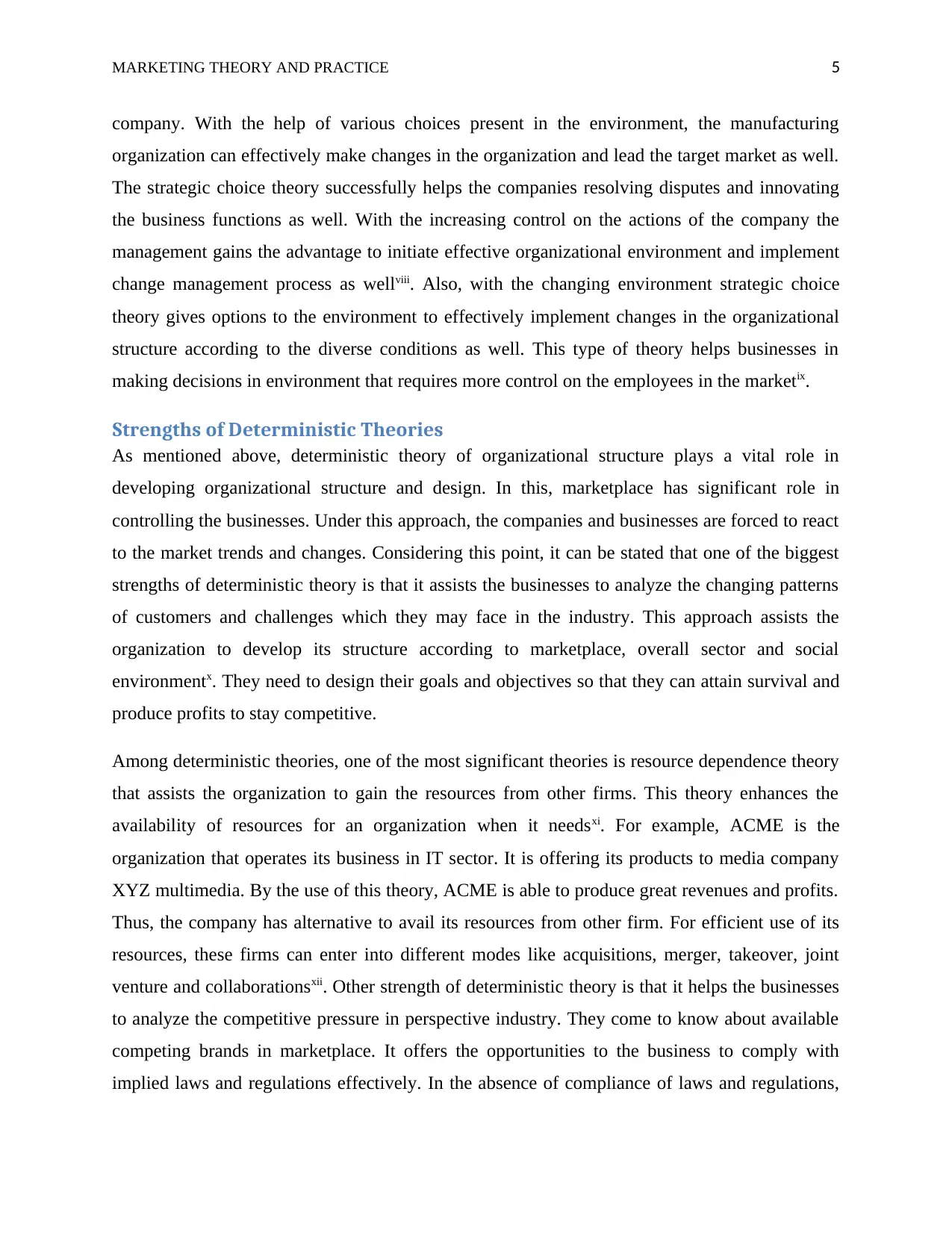
MARKETING THEORY AND PRACTICE 5
company. With the help of various choices present in the environment, the manufacturing
organization can effectively make changes in the organization and lead the target market as well.
The strategic choice theory successfully helps the companies resolving disputes and innovating
the business functions as well. With the increasing control on the actions of the company the
management gains the advantage to initiate effective organizational environment and implement
change management process as wellviii. Also, with the changing environment strategic choice
theory gives options to the environment to effectively implement changes in the organizational
structure according to the diverse conditions as well. This type of theory helps businesses in
making decisions in environment that requires more control on the employees in the marketix.
Strengths of Deterministic Theories
As mentioned above, deterministic theory of organizational structure plays a vital role in
developing organizational structure and design. In this, marketplace has significant role in
controlling the businesses. Under this approach, the companies and businesses are forced to react
to the market trends and changes. Considering this point, it can be stated that one of the biggest
strengths of deterministic theory is that it assists the businesses to analyze the changing patterns
of customers and challenges which they may face in the industry. This approach assists the
organization to develop its structure according to marketplace, overall sector and social
environmentx. They need to design their goals and objectives so that they can attain survival and
produce profits to stay competitive.
Among deterministic theories, one of the most significant theories is resource dependence theory
that assists the organization to gain the resources from other firms. This theory enhances the
availability of resources for an organization when it needsxi. For example, ACME is the
organization that operates its business in IT sector. It is offering its products to media company
XYZ multimedia. By the use of this theory, ACME is able to produce great revenues and profits.
Thus, the company has alternative to avail its resources from other firm. For efficient use of its
resources, these firms can enter into different modes like acquisitions, merger, takeover, joint
venture and collaborationsxii. Other strength of deterministic theory is that it helps the businesses
to analyze the competitive pressure in perspective industry. They come to know about available
competing brands in marketplace. It offers the opportunities to the business to comply with
implied laws and regulations effectively. In the absence of compliance of laws and regulations,
company. With the help of various choices present in the environment, the manufacturing
organization can effectively make changes in the organization and lead the target market as well.
The strategic choice theory successfully helps the companies resolving disputes and innovating
the business functions as well. With the increasing control on the actions of the company the
management gains the advantage to initiate effective organizational environment and implement
change management process as wellviii. Also, with the changing environment strategic choice
theory gives options to the environment to effectively implement changes in the organizational
structure according to the diverse conditions as well. This type of theory helps businesses in
making decisions in environment that requires more control on the employees in the marketix.
Strengths of Deterministic Theories
As mentioned above, deterministic theory of organizational structure plays a vital role in
developing organizational structure and design. In this, marketplace has significant role in
controlling the businesses. Under this approach, the companies and businesses are forced to react
to the market trends and changes. Considering this point, it can be stated that one of the biggest
strengths of deterministic theory is that it assists the businesses to analyze the changing patterns
of customers and challenges which they may face in the industry. This approach assists the
organization to develop its structure according to marketplace, overall sector and social
environmentx. They need to design their goals and objectives so that they can attain survival and
produce profits to stay competitive.
Among deterministic theories, one of the most significant theories is resource dependence theory
that assists the organization to gain the resources from other firms. This theory enhances the
availability of resources for an organization when it needsxi. For example, ACME is the
organization that operates its business in IT sector. It is offering its products to media company
XYZ multimedia. By the use of this theory, ACME is able to produce great revenues and profits.
Thus, the company has alternative to avail its resources from other firm. For efficient use of its
resources, these firms can enter into different modes like acquisitions, merger, takeover, joint
venture and collaborationsxii. Other strength of deterministic theory is that it helps the businesses
to analyze the competitive pressure in perspective industry. They come to know about available
competing brands in marketplace. It offers the opportunities to the business to comply with
implied laws and regulations effectively. In the absence of compliance of laws and regulations,
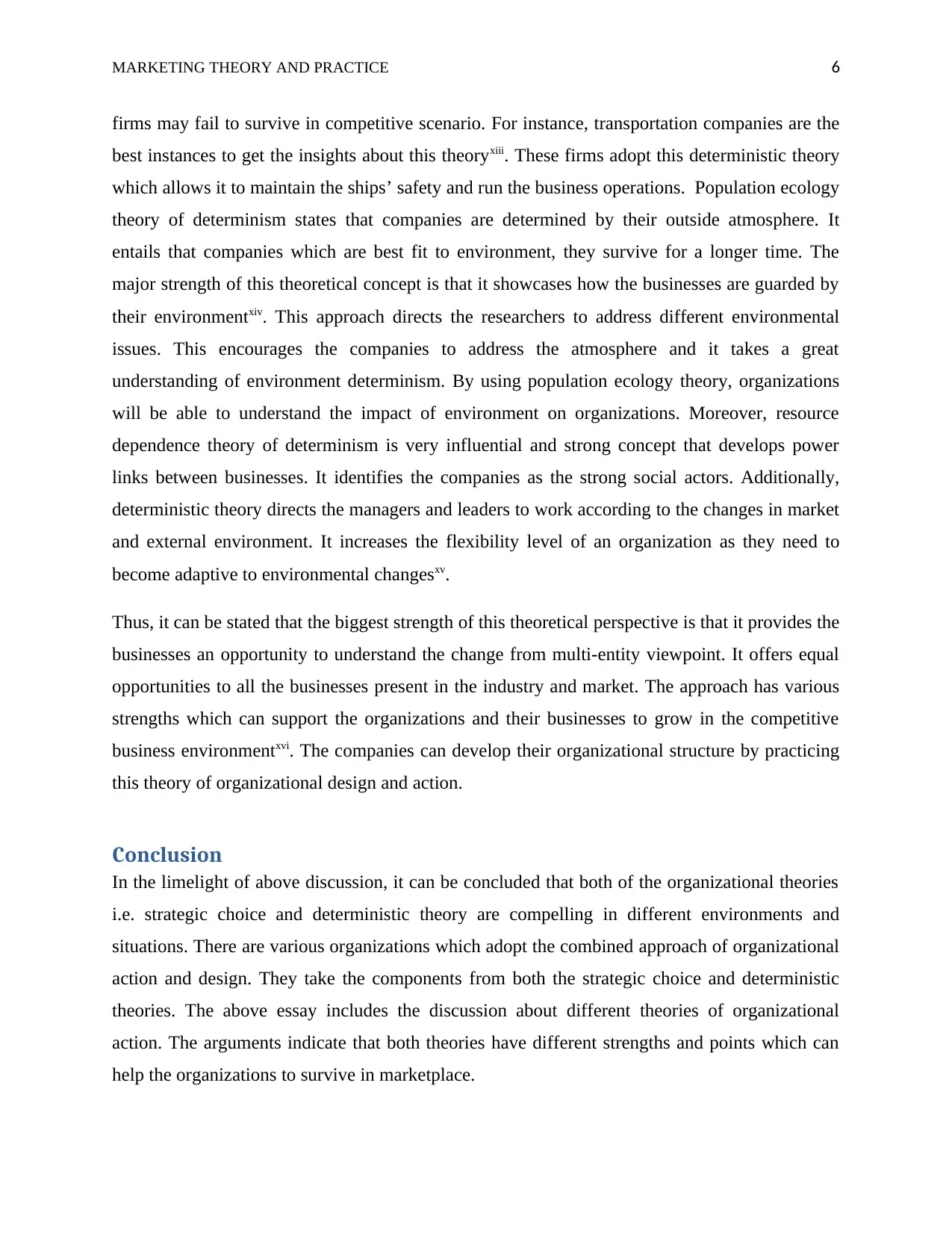
MARKETING THEORY AND PRACTICE 6
firms may fail to survive in competitive scenario. For instance, transportation companies are the
best instances to get the insights about this theoryxiii. These firms adopt this deterministic theory
which allows it to maintain the ships’ safety and run the business operations. Population ecology
theory of determinism states that companies are determined by their outside atmosphere. It
entails that companies which are best fit to environment, they survive for a longer time. The
major strength of this theoretical concept is that it showcases how the businesses are guarded by
their environmentxiv. This approach directs the researchers to address different environmental
issues. This encourages the companies to address the atmosphere and it takes a great
understanding of environment determinism. By using population ecology theory, organizations
will be able to understand the impact of environment on organizations. Moreover, resource
dependence theory of determinism is very influential and strong concept that develops power
links between businesses. It identifies the companies as the strong social actors. Additionally,
deterministic theory directs the managers and leaders to work according to the changes in market
and external environment. It increases the flexibility level of an organization as they need to
become adaptive to environmental changesxv.
Thus, it can be stated that the biggest strength of this theoretical perspective is that it provides the
businesses an opportunity to understand the change from multi-entity viewpoint. It offers equal
opportunities to all the businesses present in the industry and market. The approach has various
strengths which can support the organizations and their businesses to grow in the competitive
business environmentxvi. The companies can develop their organizational structure by practicing
this theory of organizational design and action.
Conclusion
In the limelight of above discussion, it can be concluded that both of the organizational theories
i.e. strategic choice and deterministic theory are compelling in different environments and
situations. There are various organizations which adopt the combined approach of organizational
action and design. They take the components from both the strategic choice and deterministic
theories. The above essay includes the discussion about different theories of organizational
action. The arguments indicate that both theories have different strengths and points which can
help the organizations to survive in marketplace.
firms may fail to survive in competitive scenario. For instance, transportation companies are the
best instances to get the insights about this theoryxiii. These firms adopt this deterministic theory
which allows it to maintain the ships’ safety and run the business operations. Population ecology
theory of determinism states that companies are determined by their outside atmosphere. It
entails that companies which are best fit to environment, they survive for a longer time. The
major strength of this theoretical concept is that it showcases how the businesses are guarded by
their environmentxiv. This approach directs the researchers to address different environmental
issues. This encourages the companies to address the atmosphere and it takes a great
understanding of environment determinism. By using population ecology theory, organizations
will be able to understand the impact of environment on organizations. Moreover, resource
dependence theory of determinism is very influential and strong concept that develops power
links between businesses. It identifies the companies as the strong social actors. Additionally,
deterministic theory directs the managers and leaders to work according to the changes in market
and external environment. It increases the flexibility level of an organization as they need to
become adaptive to environmental changesxv.
Thus, it can be stated that the biggest strength of this theoretical perspective is that it provides the
businesses an opportunity to understand the change from multi-entity viewpoint. It offers equal
opportunities to all the businesses present in the industry and market. The approach has various
strengths which can support the organizations and their businesses to grow in the competitive
business environmentxvi. The companies can develop their organizational structure by practicing
this theory of organizational design and action.
Conclusion
In the limelight of above discussion, it can be concluded that both of the organizational theories
i.e. strategic choice and deterministic theory are compelling in different environments and
situations. There are various organizations which adopt the combined approach of organizational
action and design. They take the components from both the strategic choice and deterministic
theories. The above essay includes the discussion about different theories of organizational
action. The arguments indicate that both theories have different strengths and points which can
help the organizations to survive in marketplace.

MARKETING THEORY AND PRACTICE 7
References
Argyris, C., 2017. Integrating the Individual and the Organization. Routledge.
Biermann, R. & Harsch, M., 2017. Resource dependence theory. In Palgrave Handbook of Inter-
Organizational Relations in World Politics (pp. 135-155). Palgrave Macmillan, London.
Burke, W.W., 2017. Organization change: Theory and practice. Sage Publications.
Chen, Z., Du, F. & Tang, X., 2018. Position and orientation best-fitting based on deterministic
theory during large scale assembly. Journal of Intelligent Manufacturing, 29(4), pp.827-837.
Davis, G. F., & Cobb, J. 2010 Resource Dependence Theory: Past and future. Research in the
Sociology of Organizations, 28, pp. 21-42.
Elsaid, N.M., Okasha, A.E. & Abdelghaly, A.A. 2013. Defining and Solving the Organizational
Structure Problems to Improve the Performanceof Ministry of State for Environmental Affairs –
Egypt. International Journal of Scientific and Research Publications, 3 (10), pp. 7-8.
Endsley, M.R., 2017. Toward a theory of situation awareness in dynamic systems. In Situational
Awareness (pp. 9-42). Routledge.
Eomnicki, A., 2018. Population ecology from the individual perspective. In Individual-based
models and approaches in ecology (pp. 23-37). Chapman and Hall/CRC.
Fuenfschilling, L. & Truffer, B., 2014. The structuration of socio-technical regimes—Conceptual
foundations from institutional theory. Research Policy, 43(4), pp.772-791.
Nienhüser, W., 2008. Resource dependence theory-How well does it explain behavior of
organizations?. management revue, pp.9-32.
Pattanaik, P.K. & Salles, M. eds., 2016. Social choice and welfare (Vol. 145). Elsevier.
Rockwood, L.L., 2015. Introduction to population ecology. John Wiley & Sons.
Schiele, H., Ellis, S.C., Eßig, M., Henke, J.W. & Kull, T.J., 2015. Managing supplier
satisfaction: Social capital and resource dependence frameworks. Australasian Marketing
Journal (AMJ), 23(2), pp.132-138.
References
Argyris, C., 2017. Integrating the Individual and the Organization. Routledge.
Biermann, R. & Harsch, M., 2017. Resource dependence theory. In Palgrave Handbook of Inter-
Organizational Relations in World Politics (pp. 135-155). Palgrave Macmillan, London.
Burke, W.W., 2017. Organization change: Theory and practice. Sage Publications.
Chen, Z., Du, F. & Tang, X., 2018. Position and orientation best-fitting based on deterministic
theory during large scale assembly. Journal of Intelligent Manufacturing, 29(4), pp.827-837.
Davis, G. F., & Cobb, J. 2010 Resource Dependence Theory: Past and future. Research in the
Sociology of Organizations, 28, pp. 21-42.
Elsaid, N.M., Okasha, A.E. & Abdelghaly, A.A. 2013. Defining and Solving the Organizational
Structure Problems to Improve the Performanceof Ministry of State for Environmental Affairs –
Egypt. International Journal of Scientific and Research Publications, 3 (10), pp. 7-8.
Endsley, M.R., 2017. Toward a theory of situation awareness in dynamic systems. In Situational
Awareness (pp. 9-42). Routledge.
Eomnicki, A., 2018. Population ecology from the individual perspective. In Individual-based
models and approaches in ecology (pp. 23-37). Chapman and Hall/CRC.
Fuenfschilling, L. & Truffer, B., 2014. The structuration of socio-technical regimes—Conceptual
foundations from institutional theory. Research Policy, 43(4), pp.772-791.
Nienhüser, W., 2008. Resource dependence theory-How well does it explain behavior of
organizations?. management revue, pp.9-32.
Pattanaik, P.K. & Salles, M. eds., 2016. Social choice and welfare (Vol. 145). Elsevier.
Rockwood, L.L., 2015. Introduction to population ecology. John Wiley & Sons.
Schiele, H., Ellis, S.C., Eßig, M., Henke, J.W. & Kull, T.J., 2015. Managing supplier
satisfaction: Social capital and resource dependence frameworks. Australasian Marketing
Journal (AMJ), 23(2), pp.132-138.
Paraphrase This Document
Need a fresh take? Get an instant paraphrase of this document with our AI Paraphraser

MARKETING THEORY AND PRACTICE 8
Shafritz, J.M., Ott, J.S. & Jang, Y.S., 2015. Classics of organization theory. Cengage Learning.
Whittington, R., 2014. Corporate Strategies in Recession and Recovery (Routledge Revivals):
Social Structure and Strategic Choice. Routledge.
Zimmermann N. 2011. Deterministic and Voluntaristic Theories of Organizational Change.
In: Dynamics of Drivers of Organizational Change. Gabler Publications.
Shafritz, J.M., Ott, J.S. & Jang, Y.S., 2015. Classics of organization theory. Cengage Learning.
Whittington, R., 2014. Corporate Strategies in Recession and Recovery (Routledge Revivals):
Social Structure and Strategic Choice. Routledge.
Zimmermann N. 2011. Deterministic and Voluntaristic Theories of Organizational Change.
In: Dynamics of Drivers of Organizational Change. Gabler Publications.
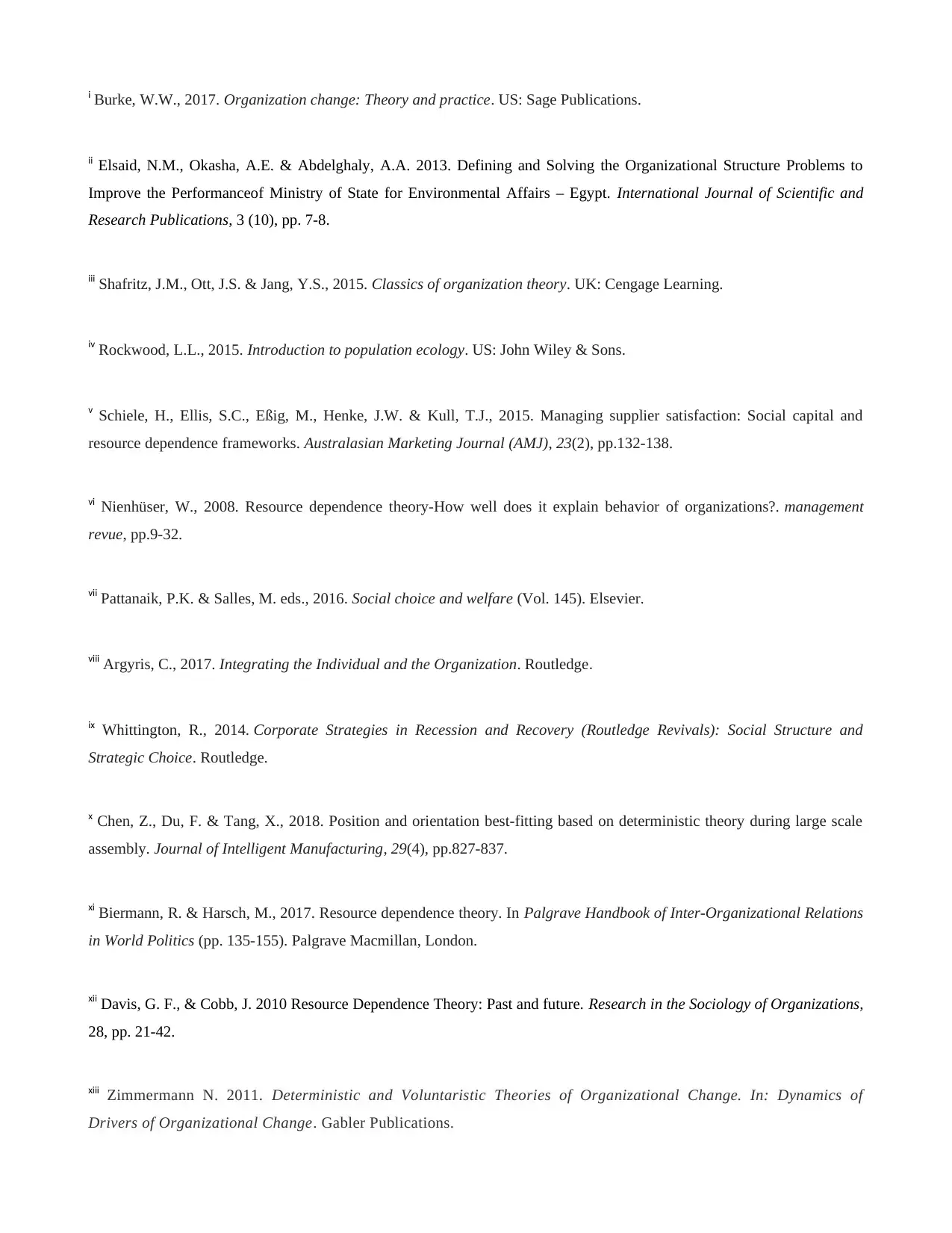
i Burke, W.W., 2017. Organization change: Theory and practice. US: Sage Publications.
ii Elsaid, N.M., Okasha, A.E. & Abdelghaly, A.A. 2013. Defining and Solving the Organizational Structure Problems to
Improve the Performanceof Ministry of State for Environmental Affairs – Egypt. International Journal of Scientific and
Research Publications, 3 (10), pp. 7-8.
iii Shafritz, J.M., Ott, J.S. & Jang, Y.S., 2015. Classics of organization theory. UK: Cengage Learning.
iv Rockwood, L.L., 2015. Introduction to population ecology. US: John Wiley & Sons.
v Schiele, H., Ellis, S.C., Eßig, M., Henke, J.W. & Kull, T.J., 2015. Managing supplier satisfaction: Social capital and
resource dependence frameworks. Australasian Marketing Journal (AMJ), 23(2), pp.132-138.
vi Nienhüser, W., 2008. Resource dependence theory-How well does it explain behavior of organizations?. management
revue, pp.9-32.
vii Pattanaik, P.K. & Salles, M. eds., 2016. Social choice and welfare (Vol. 145). Elsevier.
viii Argyris, C., 2017. Integrating the Individual and the Organization. Routledge.
ix Whittington, R., 2014. Corporate Strategies in Recession and Recovery (Routledge Revivals): Social Structure and
Strategic Choice. Routledge.
x Chen, Z., Du, F. & Tang, X., 2018. Position and orientation best-fitting based on deterministic theory during large scale
assembly. Journal of Intelligent Manufacturing, 29(4), pp.827-837.
xi Biermann, R. & Harsch, M., 2017. Resource dependence theory. In Palgrave Handbook of Inter-Organizational Relations
in World Politics (pp. 135-155). Palgrave Macmillan, London.
xii Davis, G. F., & Cobb, J. 2010 Resource Dependence Theory: Past and future. Research in the Sociology of Organizations,
28, pp. 21-42.
xiii Zimmermann N. 2011. Deterministic and Voluntaristic Theories of Organizational Change. In: Dynamics of
Drivers of Organizational Change. Gabler Publications.
ii Elsaid, N.M., Okasha, A.E. & Abdelghaly, A.A. 2013. Defining and Solving the Organizational Structure Problems to
Improve the Performanceof Ministry of State for Environmental Affairs – Egypt. International Journal of Scientific and
Research Publications, 3 (10), pp. 7-8.
iii Shafritz, J.M., Ott, J.S. & Jang, Y.S., 2015. Classics of organization theory. UK: Cengage Learning.
iv Rockwood, L.L., 2015. Introduction to population ecology. US: John Wiley & Sons.
v Schiele, H., Ellis, S.C., Eßig, M., Henke, J.W. & Kull, T.J., 2015. Managing supplier satisfaction: Social capital and
resource dependence frameworks. Australasian Marketing Journal (AMJ), 23(2), pp.132-138.
vi Nienhüser, W., 2008. Resource dependence theory-How well does it explain behavior of organizations?. management
revue, pp.9-32.
vii Pattanaik, P.K. & Salles, M. eds., 2016. Social choice and welfare (Vol. 145). Elsevier.
viii Argyris, C., 2017. Integrating the Individual and the Organization. Routledge.
ix Whittington, R., 2014. Corporate Strategies in Recession and Recovery (Routledge Revivals): Social Structure and
Strategic Choice. Routledge.
x Chen, Z., Du, F. & Tang, X., 2018. Position and orientation best-fitting based on deterministic theory during large scale
assembly. Journal of Intelligent Manufacturing, 29(4), pp.827-837.
xi Biermann, R. & Harsch, M., 2017. Resource dependence theory. In Palgrave Handbook of Inter-Organizational Relations
in World Politics (pp. 135-155). Palgrave Macmillan, London.
xii Davis, G. F., & Cobb, J. 2010 Resource Dependence Theory: Past and future. Research in the Sociology of Organizations,
28, pp. 21-42.
xiii Zimmermann N. 2011. Deterministic and Voluntaristic Theories of Organizational Change. In: Dynamics of
Drivers of Organizational Change. Gabler Publications.
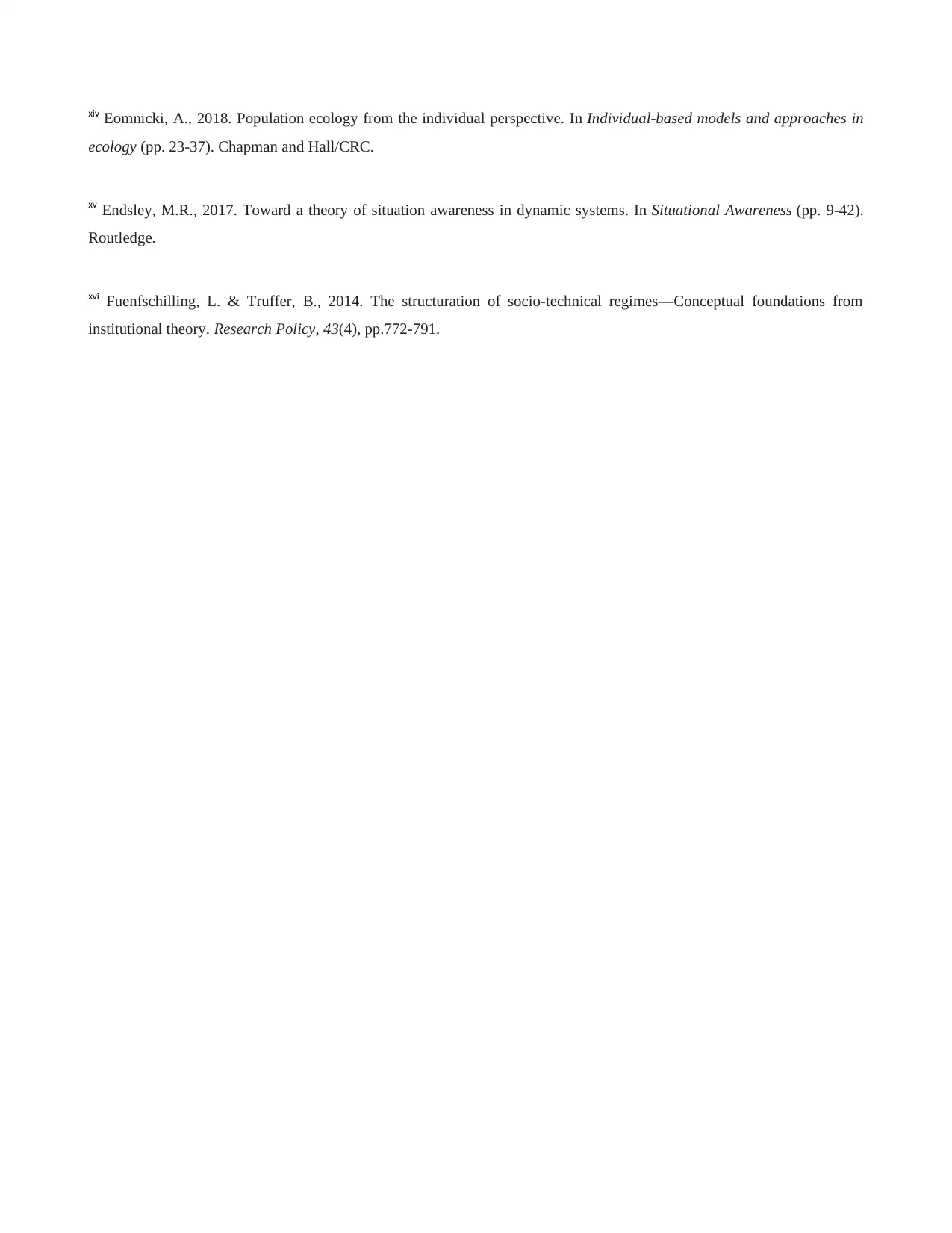
xiv Eomnicki, A., 2018. Population ecology from the individual perspective. In Individual-based models and approaches in
ecology (pp. 23-37). Chapman and Hall/CRC.
xv Endsley, M.R., 2017. Toward a theory of situation awareness in dynamic systems. In Situational Awareness (pp. 9-42).
Routledge.
xvi Fuenfschilling, L. & Truffer, B., 2014. The structuration of socio-technical regimes—Conceptual foundations from
institutional theory. Research Policy, 43(4), pp.772-791.
ecology (pp. 23-37). Chapman and Hall/CRC.
xv Endsley, M.R., 2017. Toward a theory of situation awareness in dynamic systems. In Situational Awareness (pp. 9-42).
Routledge.
xvi Fuenfschilling, L. & Truffer, B., 2014. The structuration of socio-technical regimes—Conceptual foundations from
institutional theory. Research Policy, 43(4), pp.772-791.
1 out of 10
Related Documents
Your All-in-One AI-Powered Toolkit for Academic Success.
+13062052269
info@desklib.com
Available 24*7 on WhatsApp / Email
![[object Object]](/_next/static/media/star-bottom.7253800d.svg)
Unlock your academic potential
© 2024 | Zucol Services PVT LTD | All rights reserved.




